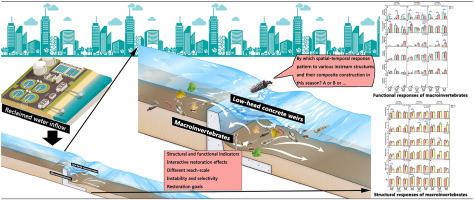Journal of Cleaner Production ( IF 11.1 ) Pub Date : 2022-08-10 , DOI: 10.1016/j.jclepro.2022.133544 Chenlu Lin , Lina Cao , Yutong Xu , Zhenxing Zhang , Haijun Yang , Hongyong Xiang , Kun Li , Yufu Gao , Thibault M. Bernhardt

|
Understanding how aquatic communities respond to various structures is important for assessing ecological effectiveness, developing theory and guiding sustainable river restoration. However, there is still minimal understanding on spatio-temporal variability of response patterns of macroinvertebrates to commonly applied low-head concrete weirs and reclaimed water in urban river restoration. Our results showed that the presence of above two structures and their interactions sometimes produce varying distribution of macroinvertebrate before and after each structure in different seasons. At higher taxa level, it is not a bad choice to utilize various structures and their composite construction to increase biological heterogeneity, to reduce costs and risk of failure, and to improve reasonably designed structures for recovery aquatic communities. Reclaimed water mainly played three major functions, sustaining more taxa; reversing the relationship of values between up and down weir on a 150 m reach-scale; maintaining macroinvertebrates indexes on a 1500 m reach-scale. These results could highlight ongoing challenges in designing structures to meet multiple goals. For stakeholders, the recommendations of this study are most suitable for river restoration focused on improving diversity of specific aquatic groups. Although case-specific, the results are analyzed within a wider framework to emphasize the importance of using various structures and composite construction in river restoration, the significance of extensive and repeated post-restoration monitoring to explore project effectiveness and provide valuable insights to river restoration.
中文翻译:

城市河流修复中再生水干预下大型无脊椎动物对常用低水头混凝土堰响应模式的时空变化(上游和下游和三个季节)
了解水生群落如何响应各种结构对于评估生态有效性、发展理论和指导可持续河流恢复非常重要。然而,对于大型无脊椎动物对常用低水头混凝土堰的响应模式的时空变异性的了解仍然很少城市河流修复中的再生水。我们的研究结果表明,上述两种结构的存在及其相互作用有时会在不同季节在每种结构之前和之后产生不同的大型无脊椎动物分布。在较高的类群水平上,利用各种结构及其复合结构来增加生物异质性,降低成本和失败风险,并改进合理设计的结构以恢复水生群落并不是一个糟糕的选择。再生水主要发挥三大作用,维持较多的类群;在 150 m 范围尺度上反转上下堰之间的值关系;在 1500 米范围内维持大型无脊椎动物指数。这些结果可以突出设计结构以满足多个目标的持续挑战。对于利益相关者,本研究的建议最适合以改善特定水生群体多样性为重点的河流修复。尽管针对具体案例,但在更广泛的框架内对结果进行了分析,以强调在河流修复中使用各种结构和复合结构的重要性,以及广泛和重复的修复后监测对探索项目有效性并为河流修复提供有价值的见解的重要性。



























 京公网安备 11010802027423号
京公网安备 11010802027423号